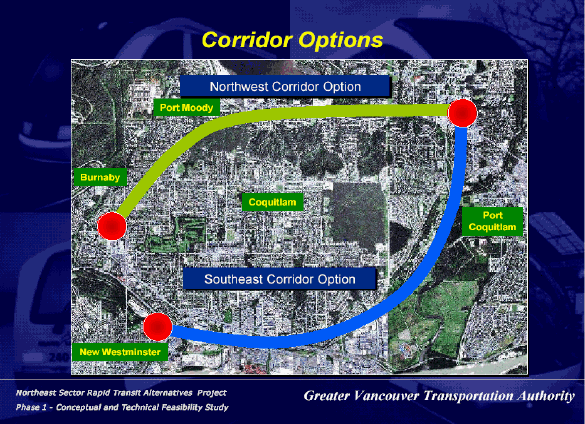|
CITY OF VANCOUVER
|
MEMORANDUM Date: January 5th, 2004
Author: Dale Bracewell
Phone: 604-871-6440
RTS No.: 3311
CC File No.: 5561
Meeting: T&T January 13, 2004
TO: |
Mayor and Council |
COPY: |
Syd Baxter, City Clerk
|
FROM: |
Dave Rudberg, General Manager of Engineering Services |
SUBJECT: |
Northeast Sector Rapid Transit Alternatives Project |
As part of Council's Standing Committee on Transportation and Traffic meeting on January 13th, 2004, TransLink staff will be making a presentation on the background materials and an update on the status of the work on the Northeast Sector Rapid Transit Alternatives Project.
BACKGROUND
Both the GVTA and GVRD Boards have approved borrowing up to $400 million to fund the GVTA's share of the cost of the Northeast Sector (NES) Rapid Transit line with a target date for the start of service being within the next decade.
In December 2002, the NES Rapid Transit Alternatives Project was started, with the purpose of an initial examination of the service, demand, land use and cost implications of a range of rapid transit technologies to serve the Northeast Sector. The work to date included examining two main corridors (see last page):
· Northwest Corridor: essentially the Port-Moody Coquitlam (PMC) corridor that is currently incorporated in local and regional plans, extends from Lougheed Station via North Road, Clark Drive through Port Moody to Coquitlam Town Centre, with a branch to Port Coquitlam
· Southeast Corridor, extends from the Millennium Skytrain via Lougheed Highway/CP Rail to Coquitlam Centre, with branches to Port Coquitlam and Port Moody
While the original PMC rapid transit line would use existing Skytrain technology, a broad range of rubber-tired and rail based vehicle technologies are being investigated in this study to determine the most cost-effective and integrated high-quality rapid transit connection between the Northeast Sector and the expanded Skytrain network.
Particular to the City of Vancouver is a third possibility, the North Fraser Corridor, which is a potential extension of service from the Southeast Corridor to the planned Richmond-Airport-Vancouver (RAV) line. This extension would make use of the existing CP Rail corridor along Kent Avenue, using rail based technology (e.g. multiple units using self-propelled diesel cars). This rail connection would benefit the City by providing new transit service to existing neighbourhoods and by supporting the East Fraserlands as a sustainable and transit-oriented development.
PHASE 1: CONCEPTUAL AND TECHNICAL FEASIBILITY STUDY
Phase 1 of the NES Rapid Transit Alternatives Project involved the development of alternative options (alignment and technology pairs). This work provided a high level, "order-of-magnitude" analysis and costing of these options, such that the merits of their feasibility could be assessed. Although some preliminary ridership estimates were prepared, it was not a detailed ridership study, nor did it go into detailed land use and environmental impact analyses. This phase was essentially an information-gathering phase and no recommendations were made to eliminate any options from consideration.
With respect to the North Fraser Corridor, it was proposed that a more detailed feasibility of a rail based connection to the RAV line be examined, preferably in the context of a region-wide rail strategy.
PHASE 2: EVALUATION OF RAPID TRANSIT ALTERNATIVES STUDY
In Phase 2, the list of rapid transit alternatives identified in Phase 1 are being further examined in terms of ridership, costs, travel time, and traffic and environmental impacts. The work has been undertaken by the IBI/Delcan consultant team, under the oversight of a Technical Steering Committee of staff from the directly involved municipalities. Vancouver staff have also been involved given the possibility of new service on the CPR tracks along Kent Avenue to connect to the RAV line.
The key deliverables for this stage of the project are to develop more detailed route and technology assessments for the various options. This includes the development and application of an evaluation framework that considers factors such as capital and operating costs, potential ridership and revenue, compatibility with municipal and regional plans, community and other impacts, etc.. A final report will be presented to the GVTA Board for information in early 2004 and is proposed to be the subject of public and municipal consultation until the end of March. It is intended for the selection of a preferred option to be completed in April 2004.
TransLink staff will be available on January 13th to answer any questions following their progress update at Council's Standing Committee on Transportation and Traffic meeting. To know more about the City's involvement, please feel free to contact Dale Bracewell of our Strategic Transportation Planning Branch at 604-871-6440.
D.H. Rudberg, P. Eng.
General Manager of Engineering Services
DJB
F:\NE Rail Study\Phase 2\T&T-Jan04 Council Memo.doc
NES Rapid Transit Alternatives Corridor Options - Phase 1 Study


